2007 CHEVROLET TRAIL BLAZER clock
[x] Cancel search: clockPage 132 of 574
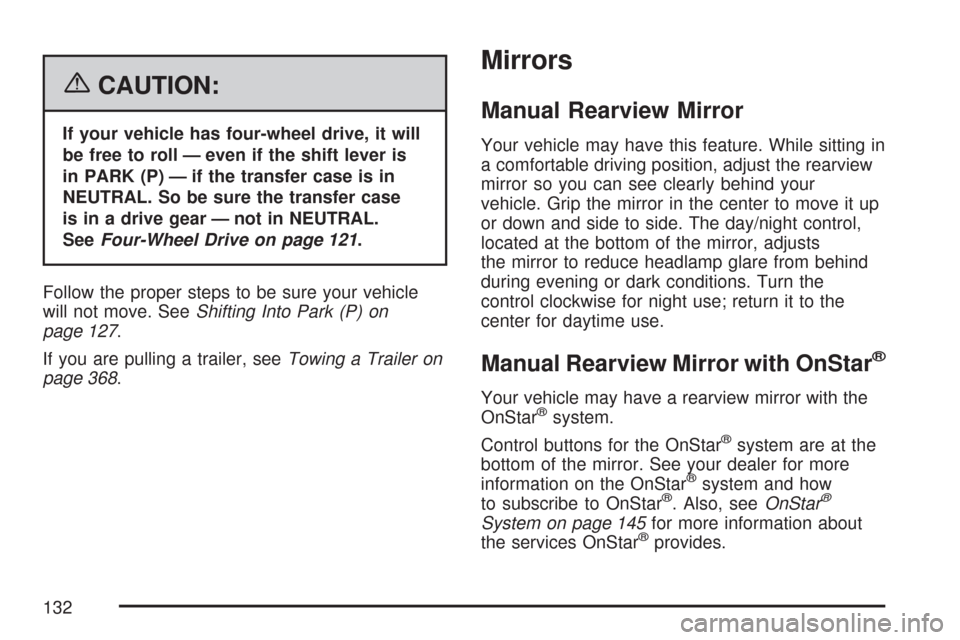
{CAUTION:
If your vehicle has four-wheel drive, it will
be free to roll — even if the shift lever is
in PARK (P) — if the transfer case is in
NEUTRAL. So be sure the transfer case
is in a drive gear — not in NEUTRAL.
SeeFour-Wheel Drive on page 121.
Follow the proper steps to be sure your vehicle
will not move. SeeShifting Into Park (P) on
page 127.
If you are pulling a trailer, seeTowing a Trailer on
page 368.
Mirrors
Manual Rearview Mirror
Your vehicle may have this feature. While sitting in
a comfortable driving position, adjust the rearview
mirror so you can see clearly behind your
vehicle. Grip the mirror in the center to move it up
or down and side to side. The day/night control,
located at the bottom of the mirror, adjusts
the mirror to reduce headlamp glare from behind
during evening or dark conditions. Turn the
control clockwise for night use; return it to the
center for daytime use.
Manual Rearview Mirror with OnStar®
Your vehicle may have a rearview mirror with the
OnStar®system.
Control buttons for the OnStar
®system are at the
bottom of the mirror. See your dealer for more
information on the OnStar
®system and how
to subscribe to OnStar®. Also, seeOnStar®
System on page 145for more information about
the services OnStar®provides.
132
Page 181 of 574
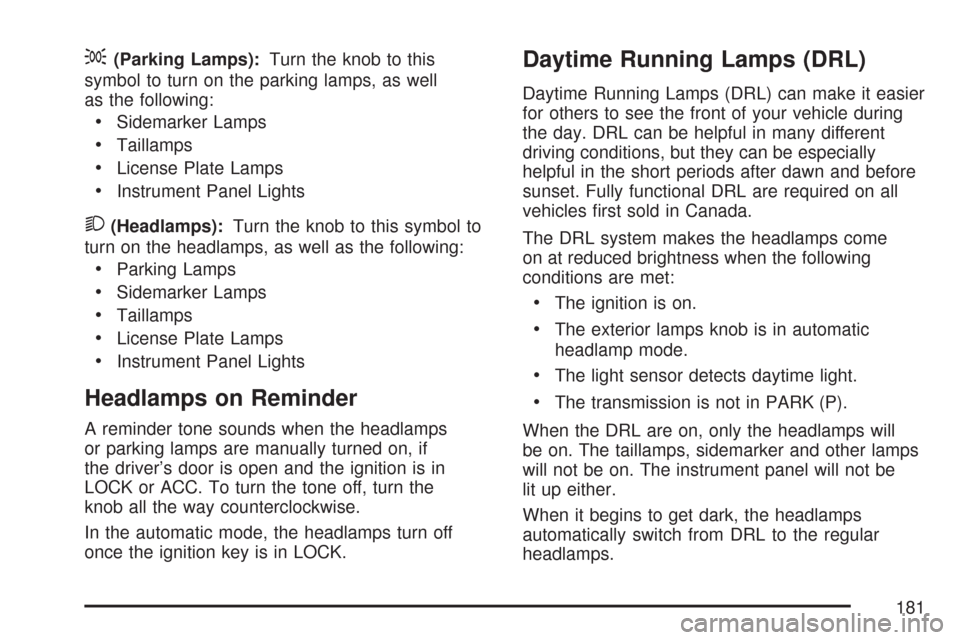
;(Parking Lamps):Turn the knob to this
symbol to turn on the parking lamps, as well
as the following:
Sidemarker Lamps
Taillamps
License Plate Lamps
Instrument Panel Lights
2(Headlamps):Turn the knob to this symbol to
turn on the headlamps, as well as the following:
Parking Lamps
Sidemarker Lamps
Taillamps
License Plate Lamps
Instrument Panel Lights
Headlamps on Reminder
A reminder tone sounds when the headlamps
or parking lamps are manually turned on, if
the driver’s door is open and the ignition is in
LOCK or ACC. To turn the tone off, turn the
knob all the way counterclockwise.
In the automatic mode, the headlamps turn off
once the ignition key is in LOCK.
Daytime Running Lamps (DRL)
Daytime Running Lamps (DRL) can make it easier
for others to see the front of your vehicle during
the day. DRL can be helpful in many different
driving conditions, but they can be especially
helpful in the short periods after dawn and before
sunset. Fully functional DRL are required on all
vehicles �rst sold in Canada.
The DRL system makes the headlamps come
on at reduced brightness when the following
conditions are met:
The ignition is on.
The exterior lamps knob is in automatic
headlamp mode.
The light sensor detects daytime light.
The transmission is not in PARK (P).
When the DRL are on, only the headlamps will
be on. The taillamps, sidemarker and other lamps
will not be on. The instrument panel will not be
lit up either.
When it begins to get dark, the headlamps
automatically switch from DRL to the regular
headlamps.
181
Page 187 of 574
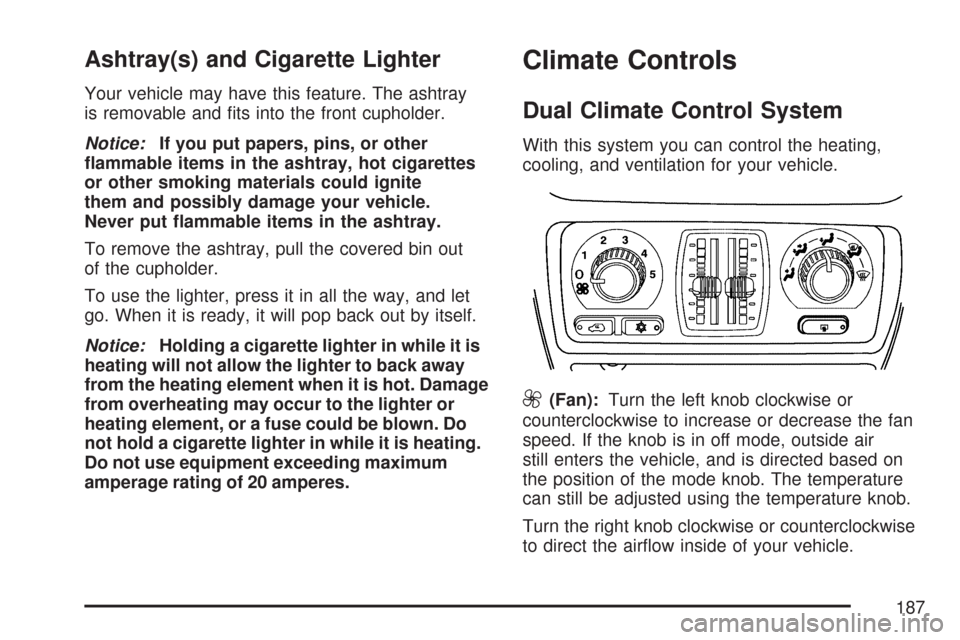
Ashtray(s) and Cigarette Lighter
Your vehicle may have this feature. The ashtray
is removable and �ts into the front cupholder.
Notice:If you put papers, pins, or other
�ammable items in the ashtray, hot cigarettes
or other smoking materials could ignite
them and possibly damage your vehicle.
Never put �ammable items in the ashtray.
To remove the ashtray, pull the covered bin out
of the cupholder.
To use the lighter, press it in all the way, and let
go. When it is ready, it will pop back out by itself.
Notice:Holding a cigarette lighter in while it is
heating will not allow the lighter to back away
from the heating element when it is hot. Damage
from overheating may occur to the lighter or
heating element, or a fuse could be blown. Do
not hold a cigarette lighter in while it is heating.
Do not use equipment exceeding maximum
amperage rating of 20 amperes.
Climate Controls
Dual Climate Control System
With this system you can control the heating,
cooling, and ventilation for your vehicle.
9(Fan):Turn the left knob clockwise or
counterclockwise to increase or decrease the fan
speed. If the knob is in off mode, outside air
still enters the vehicle, and is directed based on
the position of the mode knob. The temperature
can still be adjusted using the temperature knob.
Turn the right knob clockwise or counterclockwise
to direct the air�ow inside of your vehicle.
187
Page 189 of 574
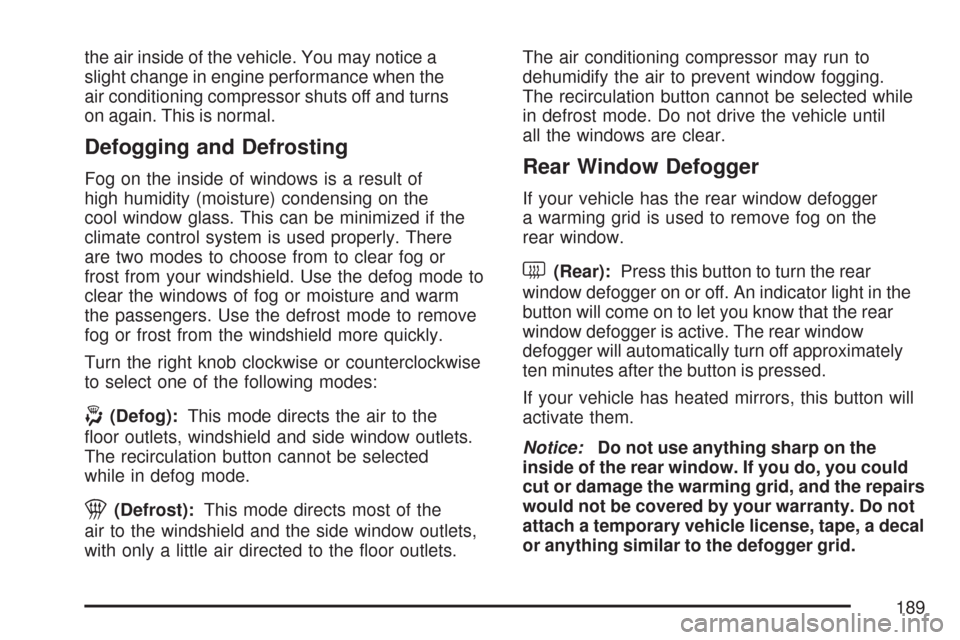
the air inside of the vehicle. You may notice a
slight change in engine performance when the
air conditioning compressor shuts off and turns
on again. This is normal.
Defogging and Defrosting
Fog on the inside of windows is a result of
high humidity (moisture) condensing on the
cool window glass. This can be minimized if the
climate control system is used properly. There
are two modes to choose from to clear fog or
frost from your windshield. Use the defog mode to
clear the windows of fog or moisture and warm
the passengers. Use the defrost mode to remove
fog or frost from the windshield more quickly.
Turn the right knob clockwise or counterclockwise
to select one of the following modes:
-(Defog):This mode directs the air to the
�oor outlets, windshield and side window outlets.
The recirculation button cannot be selected
while in defog mode.
1(Defrost):This mode directs most of the
air to the windshield and the side window outlets,
with only a little air directed to the �oor outlets.The air conditioning compressor may run to
dehumidify the air to prevent window fogging.
The recirculation button cannot be selected while
in defrost mode. Do not drive the vehicle until
all the windows are clear.
Rear Window Defogger
If your vehicle has the rear window defogger
a warming grid is used to remove fog on the
rear window.
<(Rear):Press this button to turn the rear
window defogger on or off. An indicator light in the
button will come on to let you know that the rear
window defogger is active. The rear window
defogger will automatically turn off approximately
ten minutes after the button is pressed.
If your vehicle has heated mirrors, this button will
activate them.
Notice:Do not use anything sharp on the
inside of the rear window. If you do, you could
cut or damage the warming grid, and the repairs
would not be covered by your warranty. Do not
attach a temporary vehicle license, tape, a decal
or anything similar to the defogger grid.
189
Page 190 of 574
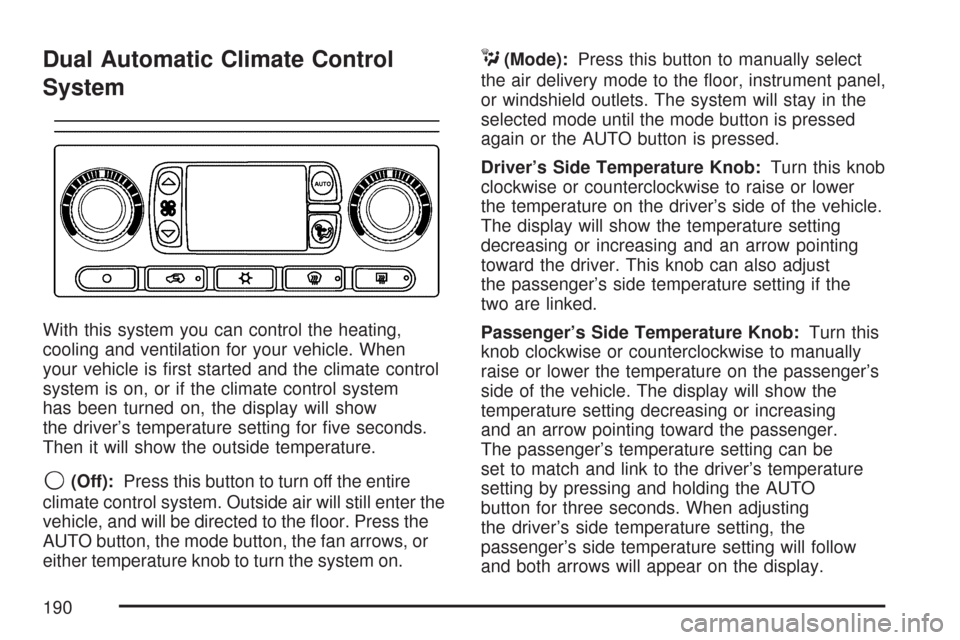
Dual Automatic Climate Control
System
With this system you can control the heating,
cooling and ventilation for your vehicle. When
your vehicle is �rst started and the climate control
system is on, or if the climate control system
has been turned on, the display will show
the driver’s temperature setting for �ve seconds.
Then it will show the outside temperature.
9(Off):Press this button to turn off the entire
climate control system. Outside air will still enter the
vehicle, and will be directed to the �oor. Press the
AUTO button, the mode button, the fan arrows, or
either temperature knob to turn the system on.
C(Mode):Press this button to manually select
the air delivery mode to the �oor, instrument panel,
or windshield outlets. The system will stay in the
selected mode until the mode button is pressed
again or the AUTO button is pressed.
Driver’s Side Temperature Knob:Turn this knob
clockwise or counterclockwise to raise or lower
the temperature on the driver’s side of the vehicle.
The display will show the temperature setting
decreasing or increasing and an arrow pointing
toward the driver. This knob can also adjust
the passenger’s side temperature setting if the
two are linked.
Passenger’s Side Temperature Knob:Turn this
knob clockwise or counterclockwise to manually
raise or lower the temperature on the passenger’s
side of the vehicle. The display will show the
temperature setting decreasing or increasing
and an arrow pointing toward the passenger.
The passenger’s temperature setting can be
set to match and link to the driver’s temperature
setting by pressing and holding the AUTO
button for three seconds. When adjusting
the driver’s side temperature setting, the
passenger’s side temperature setting will follow
and both arrows will appear on the display.
190
Page 239 of 574
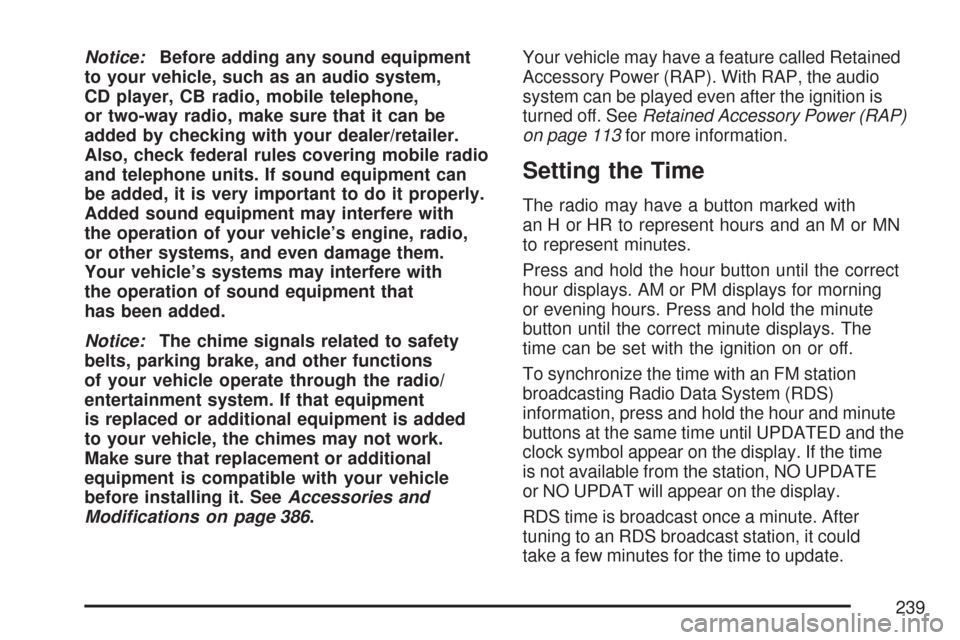
Notice:Before adding any sound equipment
to your vehicle, such as an audio system,
CD player, CB radio, mobile telephone,
or two-way radio, make sure that it can be
added by checking with your dealer/retailer.
Also, check federal rules covering mobile radio
and telephone units. If sound equipment can
be added, it is very important to do it properly.
Added sound equipment may interfere with
the operation of your vehicle’s engine, radio,
or other systems, and even damage them.
Your vehicle’s systems may interfere with
the operation of sound equipment that
has been added.
Notice:The chime signals related to safety
belts, parking brake, and other functions
of your vehicle operate through the radio/
entertainment system. If that equipment
is replaced or additional equipment is added
to your vehicle, the chimes may not work.
Make sure that replacement or additional
equipment is compatible with your vehicle
before installing it. SeeAccessories and
Modifications on page 386.Your vehicle may have a feature called Retained
Accessory Power (RAP). With RAP, the audio
system can be played even after the ignition is
turned off. SeeRetained Accessory Power (RAP)
on page 113for more information.
Setting the Time
The radio may have a button marked with
an H or HR to represent hours and an M or MN
to represent minutes.
Press and hold the hour button until the correct
hour displays. AM or PM displays for morning
or evening hours. Press and hold the minute
button until the correct minute displays. The
time can be set with the ignition on or off.
To synchronize the time with an FM station
broadcasting Radio Data System (RDS)
information, press and hold the hour and minute
buttons at the same time until UPDATED and the
clock symbol appear on the display. If the time
is not available from the station, NO UPDATE
or NO UPDAT will appear on the display.
RDS time is broadcast once a minute. After
tuning to an RDS broadcast station, it could
take a few minutes for the time to update.
239
Page 241 of 574
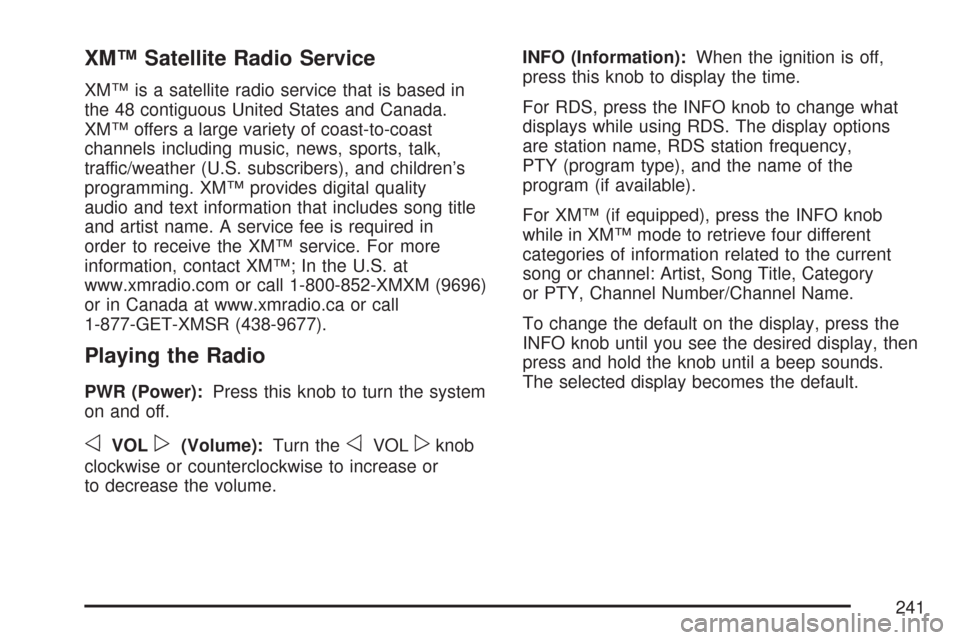
XM™ Satellite Radio Service
XM™ is a satellite radio service that is based in
the 48 contiguous United States and Canada.
XM™ offers a large variety of coast-to-coast
channels including music, news, sports, talk,
traffic/weather (U.S. subscribers), and children’s
programming. XM™ provides digital quality
audio and text information that includes song title
and artist name. A service fee is required in
order to receive the XM™ service. For more
information, contact XM™; In the U.S. at
www.xmradio.com or call 1-800-852-XMXM (9696)
or in Canada at www.xmradio.ca or call
1-877-GET-XMSR (438-9677).
Playing the Radio
PWR (Power):Press this knob to turn the system
on and off.
oVOLp(Volume):Turn theoVOLpknob
clockwise or counterclockwise to increase or
to decrease the volume.INFO (Information):When the ignition is off,
press this knob to display the time.
For RDS, press the INFO knob to change what
displays while using RDS. The display options
are station name, RDS station frequency,
PTY (program type), and the name of the
program (if available).
For XM™ (if equipped), press the INFO knob
while in XM™ mode to retrieve four different
categories of information related to the current
song or channel: Artist, Song Title, Category
or PTY, Channel Number/Channel Name.
To change the default on the display, press the
INFO knob until you see the desired display, then
press and hold the knob until a beep sounds.
The selected display becomes the default.
241
Page 251 of 574
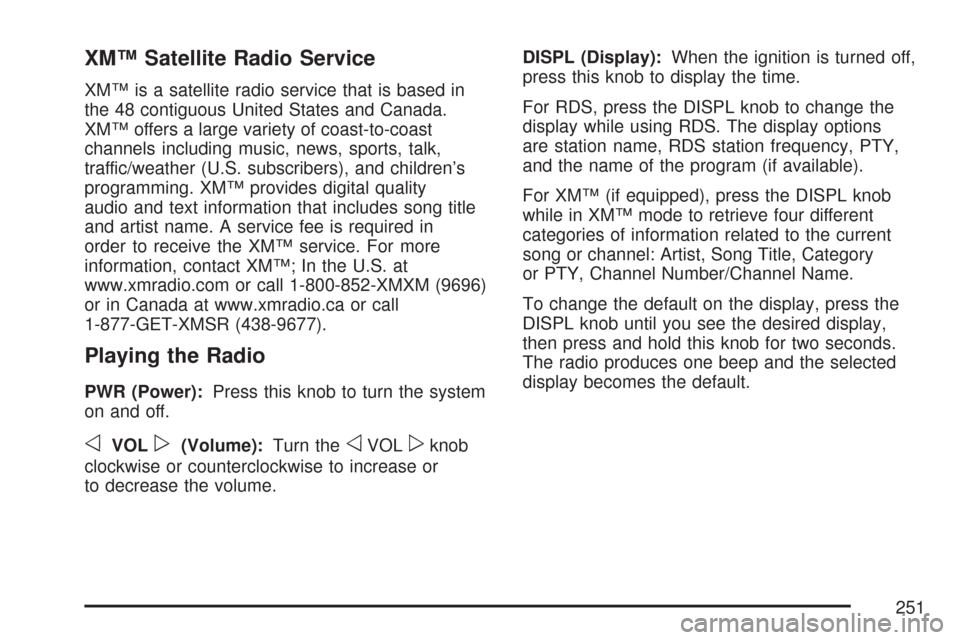
XM™ Satellite Radio Service
XM™ is a satellite radio service that is based in
the 48 contiguous United States and Canada.
XM™ offers a large variety of coast-to-coast
channels including music, news, sports, talk,
traffic/weather (U.S. subscribers), and children’s
programming. XM™ provides digital quality
audio and text information that includes song title
and artist name. A service fee is required in
order to receive the XM™ service. For more
information, contact XM™; In the U.S. at
www.xmradio.com or call 1-800-852-XMXM (9696)
or in Canada at www.xmradio.ca or call
1-877-GET-XMSR (438-9677).
Playing the Radio
PWR (Power):Press this knob to turn the system
on and off.
oVOLp(Volume):Turn theoVOLpknob
clockwise or counterclockwise to increase or
to decrease the volume.DISPL (Display):When the ignition is turned off,
press this knob to display the time.
For RDS, press the DISPL knob to change the
display while using RDS. The display options
are station name, RDS station frequency, PTY,
and the name of the program (if available).
For XM™ (if equipped), press the DISPL knob
while in XM™ mode to retrieve four different
categories of information related to the current
song or channel: Artist, Song Title, Category
or PTY, Channel Number/Channel Name.
To change the default on the display, press the
DISPL knob until you see the desired display,
then press and hold this knob for two seconds.
The radio produces one beep and the selected
display becomes the default.
251